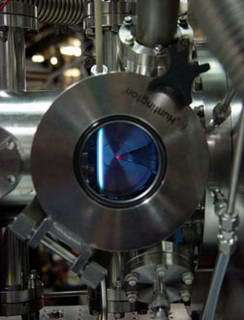Scientists discover unsuspected intermediates in the chemistry of combustion

Researchers at Sandia National Laboratories' Combustion Research Facility are part of an international team that has detected a new class of compounds previously unknown in flames, a breakthrough that could lead to soot reduction, decreases in flame pollutants, improved fuel cells, and enhanced modeling of planetary atmospheres and interstellar chemistry. A cover story on the discovery is scheduled to appear in the June 24 edition of Science magazine.
Image: This low-pressure, flame-sampling apparatus shows a rich flame burning in the vacuum chamber. The quartz cone through which flame gases are sampled is visible entering from the right of the apparatus. The tip is glowing because of incandescence of soot deposits on the cone. The burner is on the left; it can be moved horizontally so that gases are sampled from different positions in the flame. (Photo by Daniel Strong)
The discovery of these compounds, called enols, is the biggest breakthrough so far from a powerful new flame chemistry probe, operated at the Advanced Light Source at Lawrence Berkeley National Laboratory (LBNL), that was developed by researchers from Sandia, LBNL, Cornell University, and the University of Massachusetts in late 2002.
Sandia is a National Nuclear Security Administration laboratory.
This machine, and a similar device operating at the National Synchrotron Radiation Laboratory in Hefei, China, investigates molecules sampled from flames by combining mass spectrometry (to reveal molecular weight) with ionization by vacuum-ultraviolet light emitted from a synchrotron. One key capability of the machines is that they are able to distinguish isomers — molecules made of the same atoms but in different arrangements — that can have very different chemical characteristics. Enols are less-stable isomers of other well-known combustion intermediates.
They were found when the team was looking for signatures of different isomers in flames. With this finding, enols can be added to predictive computer models currently used to improve combustion efficiency and cleanliness.
“It is remarkable that, even after 150 years of flame chemistry research, new compounds can be found in flames,” said Craig Taatjes, a combustion chemistry researcher Sandia and lead author of the research paper, published in Science Express, documenting the discovery. “Enols themselves are chemically interesting; they were predicted to be transient chemical intermediates in 1880, but the first direct observation of the simplest enol, vinyl alcohol, wasn’t until 1973. Although these compounds have been elusive,” he adds, “it turns out they are just sitting in flames.”
The unanticipated detection of enols could also have a significant impact in refining models used to describe fuel cell operation and emission-free waste cleanup using supercritical water oxidation, said Taatjes. Astronomers have also observed ethenol (one of the enol compounds now identified in flames) in interstellar space. The new enol findings may provide clues as to how complex organic molecules form in interstellar space.
Besides the Sandia scientists, the team that discovered enols in flames includes researchers from Cornell University, the University of Massachusetts, the University of Bielefeld (Germany), and the National Synchrotron Radiation Laboratory in Hefei, China.
Source: Sandia National Laboratories















